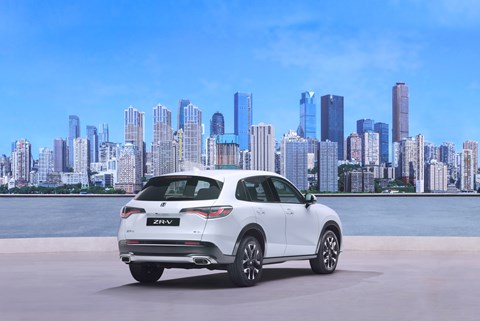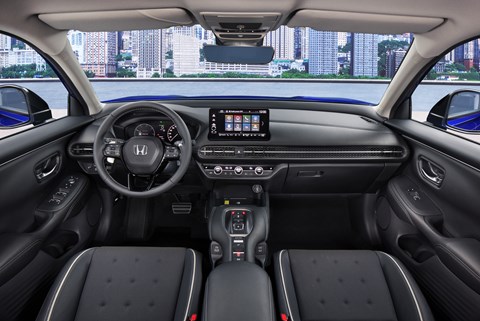► Sporty new Honda SUV unveiled
► Based on same platform as the Civic
► Fitted with same e:HEV powertrain
This is the new Honda ZR-V. It’s a sporty, hybrid-powered C-segment crossover that’s designed to squeeze between the HR-V and CR-V in the company’s SUV line-up. It adds yet another vehicle to the overly saturated family SUV segment and will into battle against the likes of the Peugeot 3008, Skoda Karoq and Volkswagen T-Cross when it hits UK showrooms in Autumn 2023.
The new Honda ZR-V is based on the same platform as the latest Civic, which means there are plenty of commonalities between the two cars. The new SUV borrows the hatchback’s infotainment suite, dashboard layout and innovative e:HEV powertrain – and Honda promises the ZR-V will share the same engaging driving experience as the hatchback that spawned it.
The ZR-V forms part of Honda’s ambitious electrification strategy which ultimately see the firm become completely carbon neutral by 2050. It won’t be offered with a fully electric powertrain, but it’ll play into the firm’s “multifaceted and multidimensional” approach to managing decarbonisation, sitting alongside its upcoming range of electric cars and hydrogen vehicles.
Tell me more about the Honda ZR-V’s powertrain
Like the Civic and Jazz, the ZR-V is powered by Honda’s e:HEV powertrain. It’s quite unusual where hybrid powertrains are concerned, as the petrol engine isn’t directly connected to the wheels. Most of the time, the engine works as a generator, producing electricity to drive the motors – and there’s a small battery on board which allows the car to travel for short distances on electric power alone.

Don’t mistake the system for a range-extender EV, though. The petrol engine can also drive the wheels. You just need to be a little more ruthless with your throttle application. When you floor the throttle, the engine is directly coupled to the front wheels via a clutch, working with the motors for maximum performance.
Honda hasn’t yet confirmed how much power the system makes in the ZR-V, but we expect its output will be identical to the Civic’s at 181bhp and 258lb/ft of torque. The car’s CO2 emissions will stand at around 130g/km, while fuel economy is claimed to be around 50mpg (both of which are impressive considering you don’t need to plug the SUV at the mains).
What about the cabin?
The ZR-V borrows its interior from the Civic, sharing the same 10.2-inch digital gauge cluster, 9.0-inch infotainment system and simple dashboard layout with an identical hidden air vent spanning the width of the cabin. Key changes include a taller driving position to suit the new SUV body and a more open design language that does away with the Civic’s high centre console.

We’ve seen the new car in the studio and were struck by how airy the cabin feels. The glasshouse is very wide and Honda’s panoramic sunroof helps to make the car looks larger on the inside than it is. Looks can be deceiving, though – and the reality is that physical space is at somewhat of a premium. Foot room under the dashboard is neat and, with the optional glass roof installed, headroom is tight in the front and rear.
The space constraints are mostly thanks to Honda’s desire to make the ZR-V a sporty, aspirational product for a younger audience. The roofline is a full 20mm lower than the larger CR-V’s – and it tapers towards the car’s tail which robs a vital inch of headroom from those in the rear.
Honda has bolted the ZR-V together very well, though, which helps to compensate for the space limitations. It shares the same robust build quality as the Civic, but it still manages to feel like a premium product with soft materials on common touchpoints and good static noise isolation. With the doors shut, it did a great job of muffling the heavy background chatter at the media event.
How much will the new Honda ZR-V cost?
Honda hasn’t yet released prices for the ZR-V, but we reckon it’ll be positioned towards the top of its segment. Honda pulled the same trick with the Civic, justifying its actions by outfitting the car with plenty of standard equipment and only offering the car with its (rather expensive) e:HEV powertrain.
In the UK, the ZR-V will be closely competing with the likes of the Skoda Karoq and the Peugeot 3008, both of which are priced from around £30,000. However, if Honda retains the Civic’s pricing strategy for the ZR-V, we reckon it’ll be priced closer to £40,000. Probably around £37,000-ish.
To give you some perspective on how Honda quantifies the worth of its technology, the cheapest Civic is around £7,000 more expensive than the equivalent Volkswagen Golf. But if the ZR-V can live up to the Civic’s reputation, we reckon you’ll easily be able to rationalise the expense.